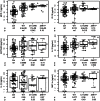Discovery of potential new gene variants and inflammatory cytokine associations with fibromyalgia syndrome by whole exome sequencing
- PMID: 23762283
- PMCID: PMC3677902
- DOI: 10.1371/journal.pone.0065033
Discovery of potential new gene variants and inflammatory cytokine associations with fibromyalgia syndrome by whole exome sequencing
Abstract
Fibromyalgia syndrome (FMS) is a chronic musculoskeletal pain disorder affecting 2% to 5% of the general population. Both genetic and environmental factors may be involved. To ascertain in an unbiased manner which genes play a role in the disorder, we performed complete exome sequencing on a subset of FMS patients. Out of 150 nuclear families (trios) DNA from 19 probands was subjected to complete exome sequencing. Since >80,000 SNPs were found per proband, the data were further filtered, including analysis of those with stop codons, a rare frequency (<2.5%) in the 1000 Genomes database, and presence in at least 2/19 probands sequenced. Two nonsense mutations, W32X in C11orf40 and Q100X in ZNF77 among 150 FMS trios had a significantly elevated frequency of transmission to affected probands (p = 0.026 and p = 0.032, respectively) and were present in a subset of 13% and 11% of FMS patients, respectively. Among 9 patients bearing more than one of the variants we have described, 4 had onset of symptoms between the ages of 10 and 18. The subset with the C11orf40 mutation had elevated plasma levels of the inflammatory cytokines, MCP-1 and IP-10, compared with unaffected controls or FMS patients with the wild-type allele. Similarly, patients with the ZNF77 mutation have elevated levels of the inflammatory cytokine, IL-12, compared with controls or patients with the wild type allele. Our results strongly implicate an inflammatory basis for FMS, as well as specific cytokine dysregulation, in at least 35% of our FMS cohort.
Conflict of interest statement
Figures


Similar articles
-
Missense mutations in the MEFV gene are associated with fibromyalgia syndrome and correlate with elevated IL-1beta plasma levels.PLoS One. 2009 Dec 30;4(12):e8480. doi: 10.1371/journal.pone.0008480. PLoS One. 2009. PMID: 20041150 Free PMC article.
-
Association between sequence variations of the Mediterranean fever gene and fibromyalgia syndrome in a cohort of Turkish patients.Clin Chim Acta. 2012 Dec 24;414:36-40. doi: 10.1016/j.cca.2012.07.019. Epub 2012 Aug 7. Clin Chim Acta. 2012. PMID: 23010357
-
A brain-derived neurotrophic factor polymorphism Val66Met identifies fibromyalgia syndrome subgroup with higher body mass index and C-reactive protein.Rheumatol Int. 2012 Aug;32(8):2479-85. doi: 10.1007/s00296-011-1990-z. Epub 2011 Jul 21. Rheumatol Int. 2012. PMID: 21773883
-
The genetics of fibromyalgia syndrome.Pharmacogenomics. 2007 Jan;8(1):67-74. doi: 10.2217/14622416.8.1.67. Pharmacogenomics. 2007. PMID: 17187510 Review.
-
Integrated review of the association of cytokines with fibromyalgia and fibromyalgia core symptoms.Biol Res Nurs. 2010 Apr;11(4):387-94. doi: 10.1177/1099800409348328. Epub 2009 Nov 22. Biol Res Nurs. 2010. PMID: 19933683 Free PMC article. Review.
Cited by
-
Melatonin as a Coadjuvant in the Treatment of Patients with Fibromyalgia.Biomedicines. 2023 Jul 12;11(7):1964. doi: 10.3390/biomedicines11071964. Biomedicines. 2023. PMID: 37509603 Free PMC article. Review.
-
Irritable bowel syndrome-diarrhea: characterization of genotype by exome sequencing, and phenotypes of bile acid synthesis and colonic transit.Am J Physiol Gastrointest Liver Physiol. 2014 Jan 1;306(1):G13-26. doi: 10.1152/ajpgi.00294.2013. Epub 2013 Nov 7. Am J Physiol Gastrointest Liver Physiol. 2014. PMID: 24200957 Free PMC article.
-
Innovations in acute and chronic pain biomarkers: enhancing diagnosis and personalized therapy.Reg Anesth Pain Med. 2025 Feb 5;50(2):110-120. doi: 10.1136/rapm-2024-106030. Reg Anesth Pain Med. 2025. PMID: 39909549 Free PMC article. Review.
-
Vitamin D in Fibromyalgia: A Causative or Confounding Biological Interplay?Nutrients. 2016 Jun 4;8(6):343. doi: 10.3390/nu8060343. Nutrients. 2016. PMID: 27271665 Free PMC article. Review.
-
A Link Between Inflammatory Mechanisms and Fibromyalgia.Adv Exp Med Biol. 2023;1411:357-378. doi: 10.1007/978-981-19-7376-5_16. Adv Exp Med Biol. 2023. PMID: 36949318
References
-
- Wolfe F, Cathey MA (1990) Assessment of functional ability in patients with fibromyalgia. Arch Intern Med 150: 460. - PubMed
-
- Wolfe F, Ross K, Anderson J, Russell IJ, Hebert L (1995) The prevalence and characteristics of fibromyalgia in the general population. Arthritis Rheum 38: 19–28. - PubMed
-
- Buskila D, Neumann L, Sibirski D, Shvartzman P (1997) Awareness of diagnostic and clinical features of fibromyalgia among family physicians. Fam Pract 14: 238–241. - PubMed
-
- Arnold LM, Hudson JI, Hess EV, Ware AE, Fritz DA, et al. (2004) Family study of fibromyalgia. Arthritis Rheum 50: 944–952. - PubMed
-
- Kato K, Sullivan PF, Evengard B, Pedersen NL (2006) Chronic widespread pain and its comorbidities: a population-based study. Arch Intern Med 166: 1649–1654. - PubMed
Publication types
MeSH terms
Substances
Grants and funding
LinkOut - more resources
Full Text Sources
Other Literature Sources
Medical
Miscellaneous

